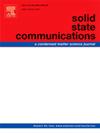First-principles investigation of structural, electronic, magnetic, elastic, and thermodynamic properties of Sc2ZrAl full-Heusler alloy
IF 2.4
4区 物理与天体物理
Q3 PHYSICS, CONDENSED MATTER
引用次数: 0
Abstract
DFT-based first-principles simulations are performed to analyze the Sc2ZrAl full-Heusler alloy. Structural analysis confirms the stability of both the normal and inverse configurations, with slight variations in the lattice parameters. Electronic structure calculations show a metallic character with significant spin polarization (up to 16.42 % with SCAN) in the normal phase, making it a strong candidate for spintronic applications. Magnetic analysis shows a total magnetic moment of 3.15 μB (SCAN) in the normal structure and a resurgence of magnetization in the inverse phase (2.82 μB) under GGA + U. The alloy exhibits mechanical stability with a high bulk modulus (80.22 GPa) and a ductile nature. Thermodynamic analysis shows that the entropy and specific heat increase with temperature and the free energy is negative, indicating a favorable thermal behavior. Ab initio molecular dynamics simulations confirm the thermal stability up to 900 K. These results point to promising applications in magnetic, spintronic, and energy-related technologies.
Sc2ZrAl全heusler合金结构、电子、磁性、弹性和热力学性质的第一性原理研究
对Sc2ZrAl全heusler合金进行了基于dft的第一性原理模拟。结构分析证实了正反构型的稳定性,晶格参数略有变化。电子结构计算表明,在正相中具有显著的自旋极化(扫描高达16.42%)的金属特征,使其成为自旋电子学应用的有力候选者。磁性分析表明,在GGA + u作用下,合金正常结构的总磁矩为3.15 μB (SCAN),反相的磁化强度为2.82 μB,合金具有较高的体模量(80.22 GPa)和韧性。热力学分析表明,系统的熵和比热随温度的升高而增大,自由能为负,表现出良好的热行为。从头算分子动力学模拟证实了热稳定性高达900k。这些结果指出了在磁性、自旋电子和能源相关技术方面有前景的应用。
本文章由计算机程序翻译,如有差异,请以英文原文为准。
求助全文
约1分钟内获得全文
求助全文
来源期刊

Solid State Communications
物理-物理:凝聚态物理
CiteScore
3.40
自引率
4.80%
发文量
287
审稿时长
51 days
期刊介绍:
Solid State Communications is an international medium for the publication of short communications and original research articles on significant developments in condensed matter science, giving scientists immediate access to important, recently completed work. The journal publishes original experimental and theoretical research on the physical and chemical properties of solids and other condensed systems and also on their preparation. The submission of manuscripts reporting research on the basic physics of materials science and devices, as well as of state-of-the-art microstructures and nanostructures, is encouraged.
A coherent quantitative treatment emphasizing new physics is expected rather than a simple accumulation of experimental data. Consistent with these aims, the short communications should be kept concise and short, usually not longer than six printed pages. The number of figures and tables should also be kept to a minimum. Solid State Communications now also welcomes original research articles without length restrictions.
The Fast-Track section of Solid State Communications is the venue for very rapid publication of short communications on significant developments in condensed matter science. The goal is to offer the broad condensed matter community quick and immediate access to publish recently completed papers in research areas that are rapidly evolving and in which there are developments with great potential impact.
 求助内容:
求助内容: 应助结果提醒方式:
应助结果提醒方式:


